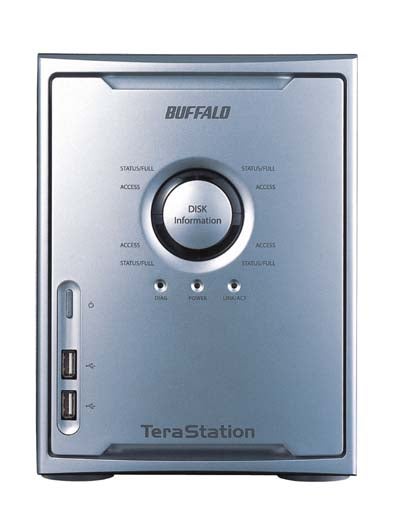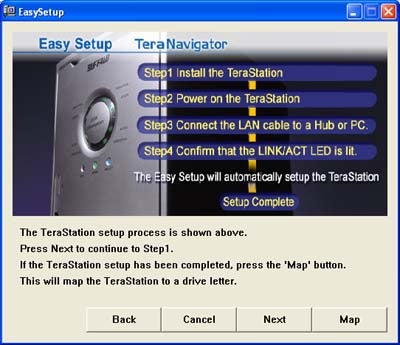Buffalo Technology TeraStation – NAS Box Review
Buffalo Technology TeraStation – NAS Box
Network attached storage is a great way to keep data safe and secure in a small business, but it doesn't come cheap. Well, it didn't until the Buffalo TeraStation arrived.

Verdict
Key Specifications
- Review Price: £617.00
The NAS appliance may be the easiest solution to adding more storage to your network, but these products are often criticised for being overly expensive – particularly for small businesses. Take Iomega’s NAS 200d for example. It offers an impressive range of storage management features but the bottom line is, for well over a grand you’re getting barely half a Terabyte of hard disk space. Wireless network expert Buffalo Technology is aiming to turn this notion on its head, as its compact TeraStation delivers a whopping 1TB of ATA storage for around £600, making it look an absolute bargain. Even more remarkable is the fact that the appliance offers full support for a wide range of RAID arrays allowing you to implement fault tolerance as well.

The TeraStation is reasonably well designed and will look good on any desktop. The front panel is home to an impressive range of status indicators showing general operations plus disk and network activity but it’ll also keep you posted on disk errors and when they have reached full capacity. As always there are sacrifices that have to be made to reach such as low price point but the hardware specification is still quite reasonable. Processing power is the weakest link as the appliance is equipped with a Motorola PowerPC 266MHz processor, but this is teamed up with a healthy 512MB of SDRAM. The network connection is well endowed with a Realtek Gigabit Ethernet controller in evidence that supports 10/100/1000Mbit/sec operations. Note that Buffalo’s controller board has all components embedded so there’s no option to upgrade. Costs have also been cut in the operating system department as the appliance uses a basic Linux kernel.
Storage is handled by a quartet of Western Digital WD2500 ATA/100 hard disks mounted in a cage above the main board. It all looks good so far but you’ll need plenty of patience when swapping out a failed hard disk. To access the hard disk cage you must first remove the four rubber feet, the main cover, the front panel, the internal chassis side panel, the disk cage mounting screws and all power and interface cables. Take it easy during reassembly as we dropped one of the last screws inside the chassis and had to dismantle the whole unit again to retrieve it.
Installation won’t take long as Buffalo’s TeraNavigator utility hunts down appliances on the network and leads you through initial configuration. You provide a name and IP address and then decide on how you want to use the hard disks. All four can be combined into a single RAID-0 stripe or you can opt for two RAID-1 mirrors which will halve capacity. For RAID-5, three disks are combined with the fourth used to store parity data or you can use all four as individual devices, or JBODs (just a bunch of disks – honest). Four USB 2.0 ports add some extra versatility as you can add external hard disks or connect USB printers and share them over the network.

A Client utility is installed on each workstation which displays all available TeraStations, their IP addresses and the status of the hard disks. You can view network shares and jump straight over to the web browser management interface. This is well designed and easy to use with all options accessible from a tidy menu to the left. Client support is basic but good enough for the target market as the TeraStation supports the CIFS/SMB and AFP protocols allowing both Windows and Macintosh clients to access it. It’ll also function as an FTP server and you can decide which options are to be active for each shared volume. Usefully, a Recycle Bin is provided for each share and can be enabled or disabled as required. These also apply to any USB drives as well. We tested these features using a Maxtor OneTouch and USB Flashdisk and the appliance worked fine with them, although it’s worth noting that NTFS partitions are not supported.
Access can be controlled with usernames and groups, while read or write permissions can be applied on an individual basis or by group membership. Disk quotas aren’t supported so you can’t limit the amount of space a user can have. Backup options are surprisingly good as up to eight full or differential tasks can be created to secure selected shares to another location on the internal drives or to an attached USB device. Each job can be scheduled to run at regular intervals and data can be compressed and encrypted. You can also copy data to another TeraStation and the management interface will show all available units on the network. Buffalo even includes an Easy Backup utility which allows your users to schedule their own backup tasks for securing selected workstation data to the appliance and restoring their own files.
”’Verdict”’
There’s a lot here to commend Buffalo for as the TeraStation offers a big serving of networked storage at a price highly suited to small businesses on a tight budget. Access controls are more limited than the higher end NAS appliances and disk removal is a real pain but for the price the TeraStation is offering a very tempting proposal. Considering the capacity, ease of use and killer price point, the TesraStation walks away with an Editor’s Choice award.

